Investigation of Convective and Radiative Heat Transfer of 21700 Lithium-Ion Battery Cells
Abstract
1. Introduction
- How much heat can be dissipated by radiative heat transfer dynamics using a simple cylindrical cell?
- How do the heat transfer dynamics evolve at different discharge powers?
- How can the amount of radiative heat be increased (E-value)?
- What practical solutions can be applied to these questions?
- How significant will this application be for a given example?
2. Materials and Methods
2.1. Method Development Computational Fluid Dynamics (CFD)
2.1.1. Heat Transfer Modeling
2.1.2. Radiation Modeling
2.1.3. Heat Generation Modeling
2.2. Physical Testing
2.3. CFD Model Parameters
2.3.1. Mesh Settings
2.3.2. Shell Layer vs. Case Geometry in the Mesh
2.3.3. Radiation Model Evaluation
2.3.4. Material Properties Used for the Simulations
3. Results and Discussion
3.1. Summary of the Measurements
Heat Generation Model
3.2. Simulation Cases and Correlation
3.3. Temperature Evaluation Under Different Emissivity Conditions
3.4. Heat Transfer Mechanisms
3.5. Thermal Performance of Polymer Case Volume
3.6. Physical Testing and Validation
4. Conclusions
Author Contributions
Funding
Data Availability Statement
Acknowledgments
Conflicts of Interest
Abbreviations
| BTM | Battery Thermal Management |
| CFD | Computational Fluid Dynamics |
| EV | Electric Vehicle |
| FDOM | Finite Volume Discrete Ordinates Method |
| IHTA | Inverse Heat Transfer Analysis |
| OCV | Open Circuit Voltage |
| PCM | Phase Change Material |
| PLA | Phase Change Material |
| S2S | Surface to Surface |
| SOC | State of Charge |
| UAS | Unmanned Aerial System |
References
- Waldmann, T.; Scurtu, R.G.; Richter, K.; Wohlfahrt-Mehrens, M. 18650 vs. 21700 Li-Ion Cells—A Direct Comparison of Electrochemical, Thermal, and Geometrical Properties. J. Power Sources 2020, 472, 228614. [Google Scholar] [CrossRef]
- Quinn, J.B.; Waldmann, T.; Richter, K.; Kasper, M.; Wohlfahrt-Mehrens, M. Energy Density of Cylindrical Li-Ion Cells: A Comparison of Commercial 18650 to the 21700 Cells. J. Electrochem. Soc. 2018, 165, A3284–A3291. [Google Scholar] [CrossRef]
- Ohneseit, S.; Finster, P.; Floras, C.; Lubenau, N.; Uhlmann, N.; Seifert, H.J.; Ziebert, C. Thermal and Mechanical Safety Assessment of Type 21700 Lithium-Ion Batteries with NMC, NCA and LFP Cathodes–Investigation of Cell Abuse by Means of Accelerating Rate Calorimetry (ARC). Batteries 2023, 9, 237. [Google Scholar] [CrossRef]
- Saxon, A.; Yang, C.; Santhanagopalan, S.; Keyser, M.; Colclasure, A. Li-Ion Battery Thermal Characterization for Thermal Management Design. Batteries 2024, 10, 136. [Google Scholar] [CrossRef]
- Samsung SDI Co., Ltd. INR21700-50S Lithium-Ion Rechargeable Cell Specification; Version 0.2; Samsung SDI: Yongin-si, Republic of Korea, 2020; Available online: https://www.dnkpower.com/wp-content/uploads/2022/07/SAMSUNG-INR21700-50S-Cell-Specification.pdf (accessed on 17 June 2025).
- Buidin, T.I.C.; Mariasiu, F. Battery Thermal Management Systems: Current Status and Design Approach of Cooling Technologies. Energies 2021, 14, 4879. [Google Scholar] [CrossRef]
- Li, J.; Zhu, Z. Battery Thermal Management Systems of Electric Vehicles Space for Picture. Master’s Thesis, Division of Vehicle Engineering & Autonomous Systems, Road Vehicle Aerodynamics and Thermal Management, Chalmers University of Technology, Göteborg, Sweden, 2014. [Google Scholar]
- Shadman Rad, M.; Danilov, D.L.; Baghalha, M.; Kazemeini, M.; Notten, P.H.L. Adaptive Thermal Modeling of Li-Ion Batteries. Electrochim. Acta 2013, 102, 183–195. [Google Scholar] [CrossRef]
- Sheng, L.; Zhang, Z.; Su, L.; Zhang, H.; Zhang, H.; Li, K.; Fang, Y.; Ye, W. A Calibration Calorimetry Method to Investigate the Thermal Characteristics of a Cylindrical Lithium-Ion Battery. Int. J. Therm. Sci. 2021, 165, 106891. [Google Scholar] [CrossRef]
- Hwang, F.S.; Confrey, T.; Scully, S.; Callaghan, D.; Nolan, C.; Kent, N.; Flannery, B. Modelling of Heat Generation in an 18650 Lithium-Ion Battery Cell under Varying Discharge Rates. In Proceedings of the 5th Thermal and Fluids Engineering Summer Conference, New Orleans, LA, USA, 5–8 April 2020; Begell House Inc.: Danbury, CT, USA, 2020; Volume 2020, pp. 333–341. [Google Scholar]
- Tan, Y.; Li, Y.; Gu, Y.; Liu, W.; Fang, J.; Pan, C. Numerical Study on Heat Generation Characteristics of Charge and Discharge Cycle of the Lithium-Ion Battery. Energies 2024, 17, 178. [Google Scholar] [CrossRef]
- Tan, Z.M.; Liu, J.Y.; Li, Q. Importance of Heat Transfer by Radiation in Li-Ion Batteries during Thermal Abuse. Electrochem. Solid-State Lett. 2000, 3, 305–308. [Google Scholar]
- Gümüşsu, E.; Ekici, Ö.; Köksal, M. 3-D CFD Modeling and Experimental Testing of Thermal Behavior of a Li-Ion Battery. Appl. Therm. Eng. 2017, 120, 484–495. [Google Scholar] [CrossRef]
- Liu, J.; Chavan, S.; Kim, S.C. Investigation of the Electrochemical and Thermal Characteristics of NCM811-21700 Cylindrical Lithium-Ion Battery: A Numerical Study and Model Validation. Energies 2023, 16, 6407. [Google Scholar] [CrossRef]
- Madani, S. Experimental Study of the Heat Generation of a Lithium-Ion Battery. ECS Trans. 2020, 99, 419–428. [Google Scholar] [CrossRef]
- Huang, R.; Xu, Y.; Wu, Q.; Chen, J.; Chen, F.; Yu, X. Simulation Study on Heat Generation Characteristics of Lithium-Ion Battery Aging Process. Electronics 2023, 12, 1444. [Google Scholar] [CrossRef]
- Du, J.; Tao, H.; Chen, Y.; Yuan, X.; Lian, C.; Liu, H. Thermal Management of Air-Cooling Lithium-Ion Battery Pack. Chin. Phys. Lett. 2021, 38, 118201. [Google Scholar] [CrossRef]
- Liu, H.; Yang, K.; Gao, F.; Chen, H.; Hui, D.; Zhang, H. The Thermal Simulation Research of Lithium Ion Battery Pack. Destech Trans. Eng. Technol. Res. 2017, mdm. [Google Scholar] [CrossRef][Green Version]
- Lee, G. Lectro-Thermal Analysis of a Pouch-Type Lithium-Ion Battery with a High Discharge Rate for Urban Air Mobility. Batteries 2023, 9, 476. [Google Scholar] [CrossRef]
- Madani, S.; Schaltz, E.; Kær, S.K. Thermal Simulation of Phase Change Material for Cooling of a Lithium-Ion Battery Pack. Electrochem 2020, 1, 439–449. [Google Scholar] [CrossRef]
- Madani, S. Analysis of a Phase Change Material for Thermal Management of a Lithium-Ion Battery. ECS Trans. 2020, 99, 411–418. [Google Scholar] [CrossRef]
- Zhao, R.; Liu, J.; Ma, F. A Comprehensive Comparison of the Phase Change Material-Based Internal and External Cooling Systems. ECS Trans. 2020, 97, 195. [Google Scholar] [CrossRef]
- Chen, H.; Buston, J.; Gill, J.; Howard, D.; Williams, R.; Read, E. A Simplified Mathematical Model for Heating-Induced Thermal Runaway of Lithium-Ion Batteries. J. Electrochem. Soc. 2021, 168, 010502. [Google Scholar] [CrossRef]
- Madani, S.; Ziebert, C.; Marzband, M. Thermal Behavior Modeling of Lithium-Ion Batteries: A Comprehensive Review. Symmetry 2023, 15, 1597. [Google Scholar] [CrossRef]
- Wang, Z.; Ma, J.; Zhang, L. Finite Element Thermal Model and Simulation for a Cylindrical Li-Ion Battery. IEEE Access 2017, 5, 15372–15379. [Google Scholar] [CrossRef]
- Balmer, R. Modern Engineering Thermodynamics; Academic Press: Cambridge, MA, USA, 2011. [Google Scholar]
- Moukalled, F.; Mangani, L.; Darwish, M. Fluid Mechanics and Its Applications The Finite Volume Method in Computational Fluid Dynamics; Springer International Publishing: Cham, Switzerland, 2016; Volume 113, ISBN 978-3-319-16873-9/978-3-319-16874-6. [Google Scholar]
- Versteeg, H.K.; Malalasekera, W. An Introduction to Computational Fluid Dynamics, 2nd ed.; Pearson Education Limited: Harlow, UK, 2007; Volume 2, ISBN 978-0-13-127498-3. [Google Scholar]
- Welahettige, P.; Vaagsaether, K. Comparison of OpenFOAM and ANSYS Fluent. In Proceedings of the 9th EUROSIM Congress on Modelling and Simulation (EUROSIM 2016) and the 57th SIMS Conference on Simulation and Modelling (SIMS 2016), Oulu, Finland, 13–15 September 2016; Linköping University Electronic Press: Linköping, Sweden, 2016; Volume 142, pp. 1005–1012. [Google Scholar]
- Zou, Y.; Zhao, X.; Chen, Q. Comparison of STAR-CCM+ and ANSYS Fluent for Simulating Indoor Airflows. Build. Simul. 2017, 11, 165–174. [Google Scholar] [CrossRef]
- ANSYS, Inc. ANSYS Fluent Theory Guide; ANSYS, Inc.: Canonsburg, PA, USA, 2021; pp. 167–206. [Google Scholar]
- Shelkea, A.V.; Buston, J.E.H.; Gill, J.; Howard, D.; Williams, R.C.E.; Read, E.; Abaza, A.; Cooper, B.; Richards, P.; Wen, J.X. Combined Numerical and Experimental Studies of 21700 Lithium-Ion Battery Thermal Runaway Induced by Different Thermal Abuse. Int. J. Heat. Mass. Transf. 2022, 194, 123099. [Google Scholar] [CrossRef]
- Verdério Júnior, S.A.; Scalon, V.L.; Avallone, E.; Mioralli, P.C. Numerical Validation of Viewfactor and FVDOM Radiation Models of Openfoam ® and Application in the Study of Food Furnaces. Ingeniare 2018, 26, 546–556. [Google Scholar] [CrossRef]
- Cao, R.; Zhang, X.; Yang, H. Prediction of the Heat Generation Rate of Lithium-Ion Batteries Based on Three Machine Learning Algorithms. Batteries 2023, 9, 165. [Google Scholar] [CrossRef]
- Barai, A.; Widanage, W.D.; Marco, J.; Mcgordon, A.; Jennings, P. A Study of the Open Circuit Voltage Characterization Technique and Hysteresis Assessment of Lithium-Ion Cells. J. Power Sources 2015, 295, 99–107. [Google Scholar] [CrossRef]
- Birkl, C.R.; McTurk, E.; Roberts, M.R.; Bruce, P.G.; Howey, D.A. A Parametric Open Circuit Voltage Model for Lithium Ion Batteries. J. Electrochem. Soc. 2015, 162, A2271–A2280. [Google Scholar] [CrossRef]
- Lei, H.; Han, Y.Y. The Measurement and Analysis for Open Circuit Voltage of Lithium-Ion Battery. J. Phys. Conf. Ser. 2019, 1325, 012173. [Google Scholar] [CrossRef]
- Sarmadian, A.; Yu, Y.; Marco, J.; Shollock, B.; Restuccia, F. An Experimentally-Verified Thermal-Electrochemical Simulation Model of a 21700 Cell Using a Lumped Semi-Empirical Battery Model. In Proceedings of the 16th International Conference on Heat Transfer, Fluid Mechanics and Thermodynamics (HEFAT2022), Amsterdam, The Netherlands, 8–10 August 2022; pp. 128–133. [Google Scholar]
- Baccouche, I.; Jemmali, S.; Manai, B.; Omar, N.; Essoukri Ben Amara, N. Improved OCV Model of a Li-Ion NMC Battery for Online SOC Estimation Using the Extended Kalman Filter. Energies 2017, 10, 764. [Google Scholar] [CrossRef]
- Baccouche, I.; Essoukri, N.; Amara, B.; Jemmali, S.; Mlayah, A.; Manai, B. Implementation of an Improved Coulomb-Counting Algorithm Based on a Piecewise SOC-OCV Relationship for SOC Estimation of Li-IonBattery Implementation of an Improved Coulomb-Counting Algorithm Based on a Piecewise SOC-OCV Relationship for SOC Estimation of Li-Ion Battery. arXiv 2018, arXiv:1803.10654. [Google Scholar] [CrossRef]
- Yu, Q.Q.; Xiong, R.; Wang, L.Y.; Lin, C. A Comparative Study on Open Circuit Voltage Models for Lithium-Ion Batteries. Chin. J. Mech. Eng. (Engl. Ed.) 2018, 31, 65. [Google Scholar] [CrossRef]
- Sundaresan, S.; Devabattini, B.C.; Kumar, P.; Pattipati, K.R.; Balasingam, B. Tabular Open Circuit Voltage Modelling of Li-Ion Batteries for Robust SOC Estimation. Energies 2022, 15, 9142. [Google Scholar] [CrossRef]
- Han, U.; Choi, H.; Lee, H.; Lee, H. Inverse Heat Transfer Analysis Method to Determine the Entropic Coefficient of Reversible Heat in Lithium-Ion Battery. Int. J. Energy Res. 2023, 2023, 9929496. [Google Scholar] [CrossRef]
- Wen, C.D.; Mudawar, I. Modeling the Effects of Surface Roughness on the Emissivity of Aluminum Alloys. Int. J. Heat. Mass. Transf. 2006, 49, 4279–4289. [Google Scholar] [CrossRef]
- Yu, H.; Zhang, H.; Shi, J.; Liu, S.; Yi, Z.; Xu, S.; Wang, X. Thermal Parameters of Cylindrical Power Batteries: Quasi-Steady State Heat Guarding Measurement and Thermal Management Strategies. Appl. Therm. Eng. 2023, 231, 120959. [Google Scholar] [CrossRef]
- Wang, C.L.; Leong, J.C. Analysis of Thermal Management Strategies for 21700 Lithium-Ion Batteries Incorporating Phase Change Materials and Porous Copper Foam with Different Battery Orientations. Energies 2024, 17, 1553. [Google Scholar] [CrossRef]
- Liu, G.; Ouyang, M.; Lu, L.; Li, J.; Han, X. Analysis of the Heat Generation of Lithium-Ion Battery during Charging and Discharging Considering Different Influencing Factors. J. Therm. Anal. Calorim. 2014, 116, 1001–1010. [Google Scholar] [CrossRef]
- Lin, C.; Wen, H.; Liu, L.; Liu, S.; Ma, T.; Fan, B.; Wang, F. Heat Generation Quantification of High-Specific-Energy 21700 Battery Cell Using Average and Variable Specific Heat Capacities. Appl. Therm. Eng. 2021, 184, 116215. [Google Scholar] [CrossRef]










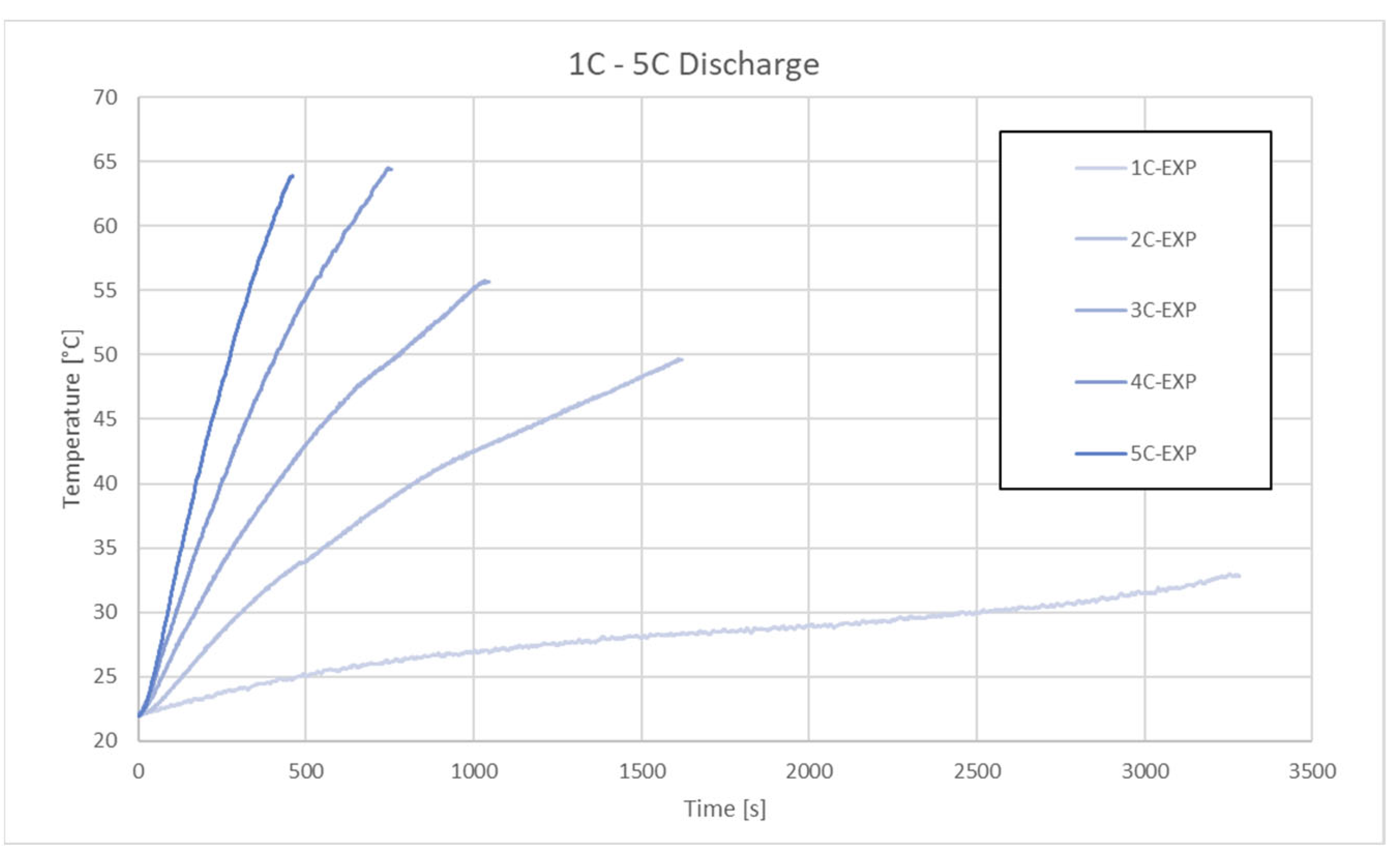

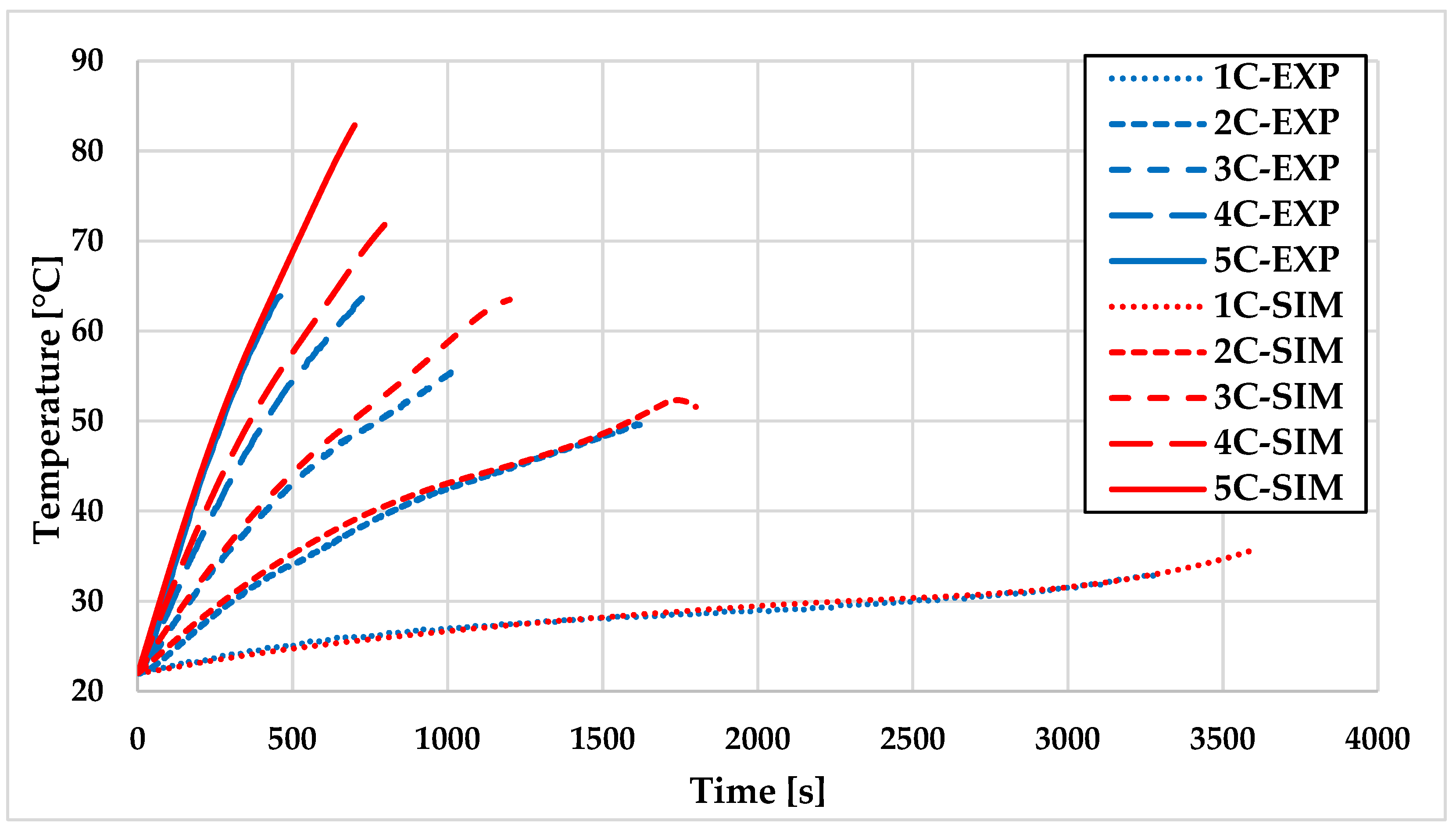
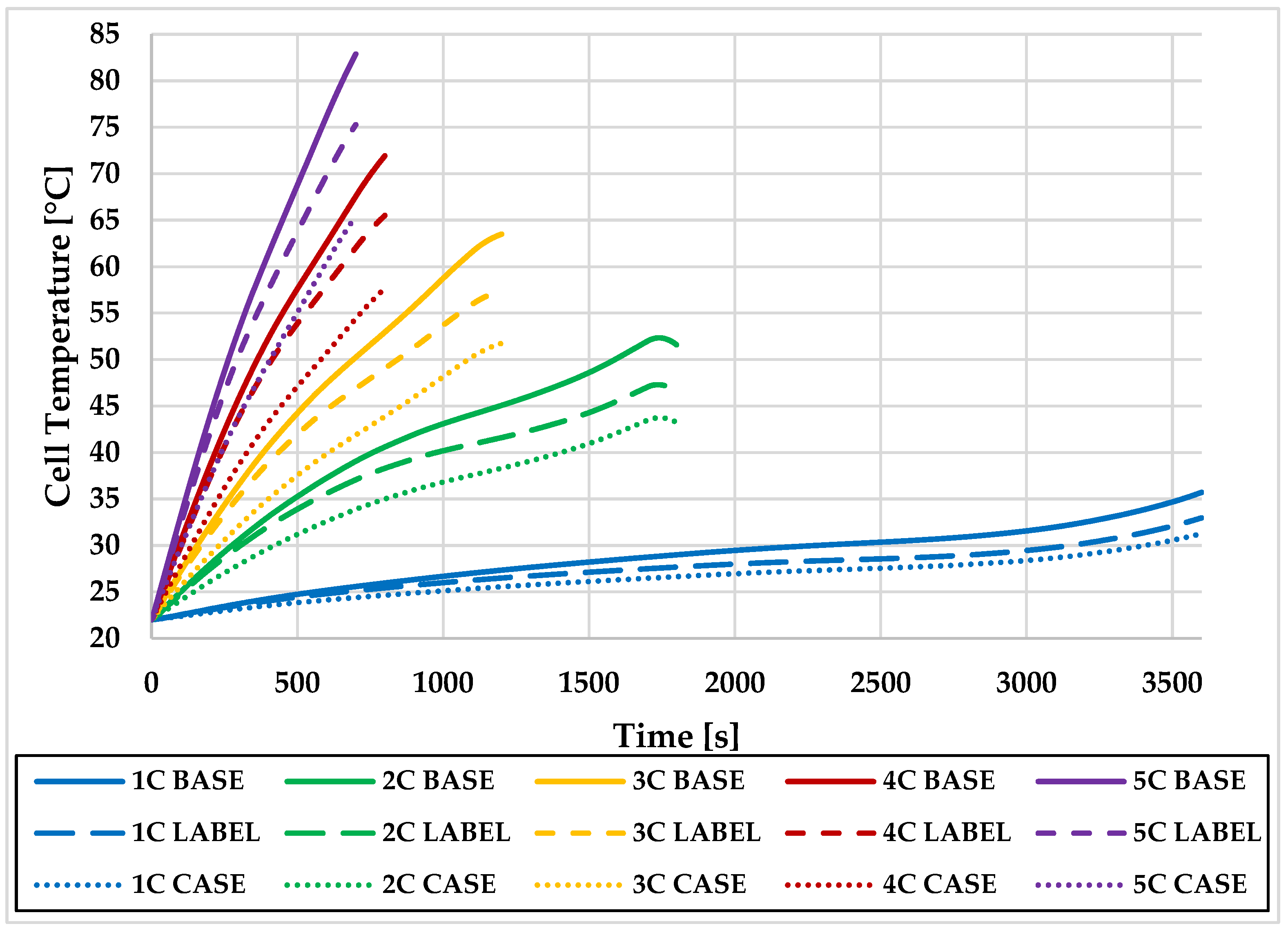
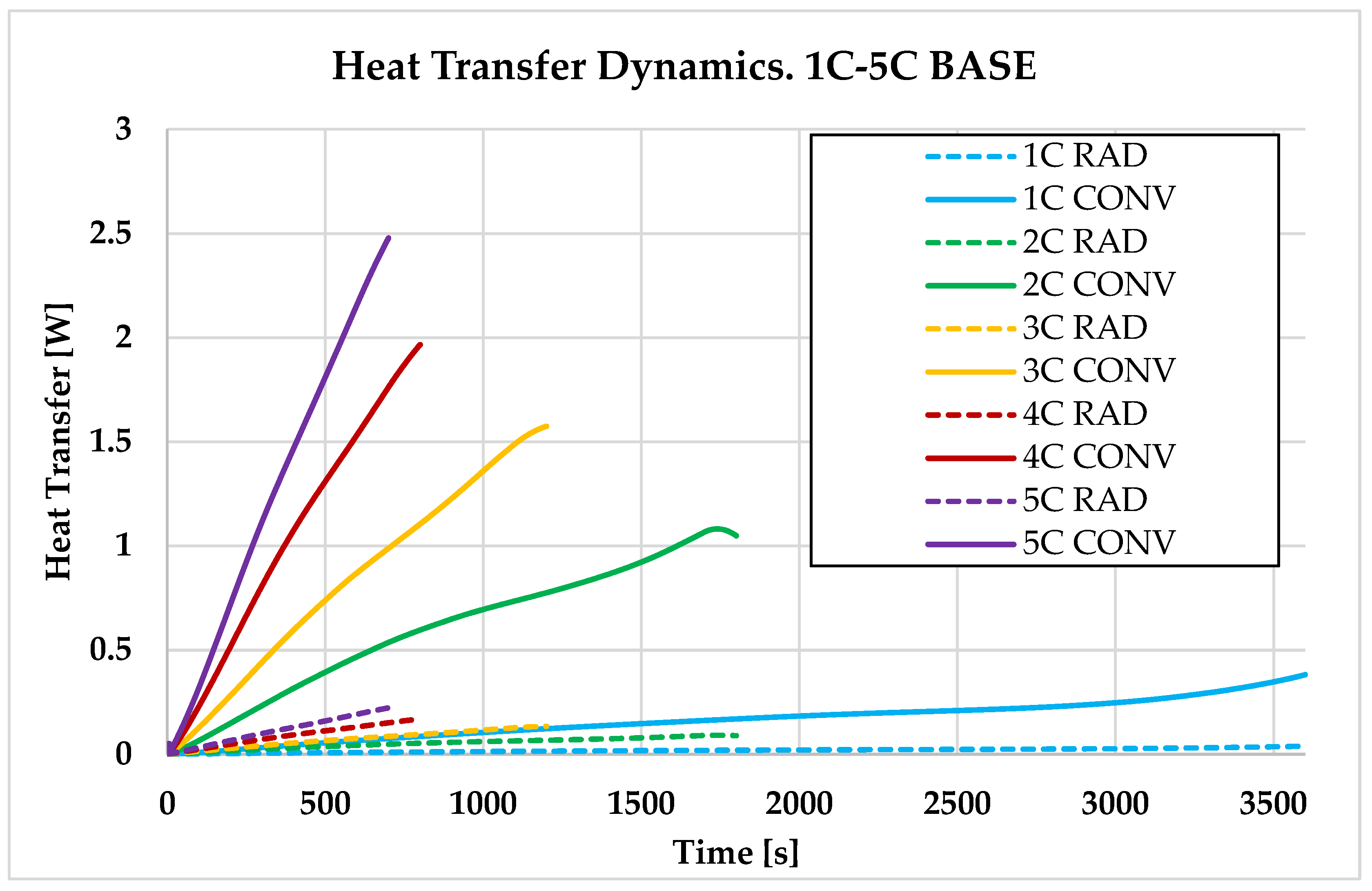
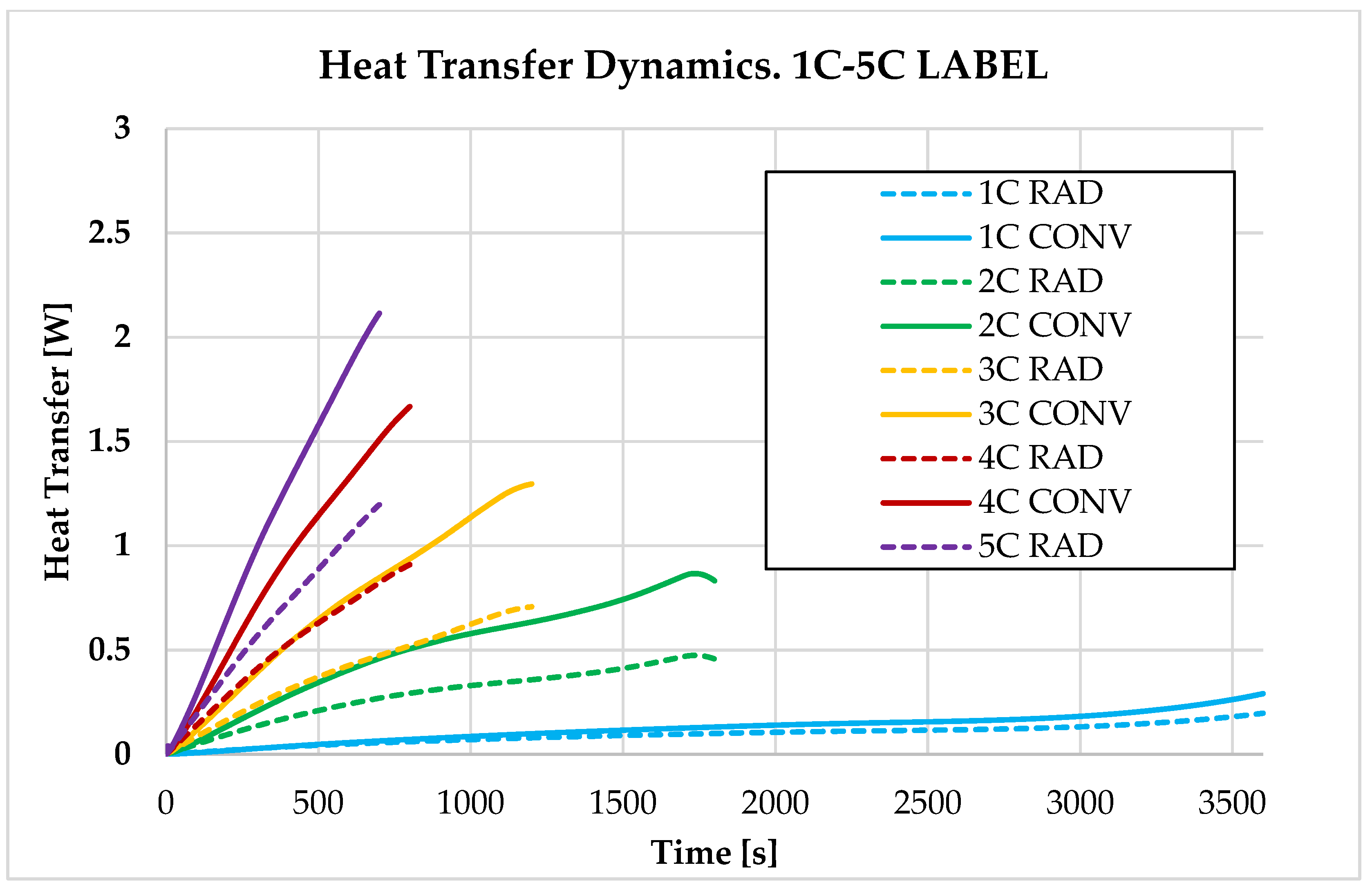
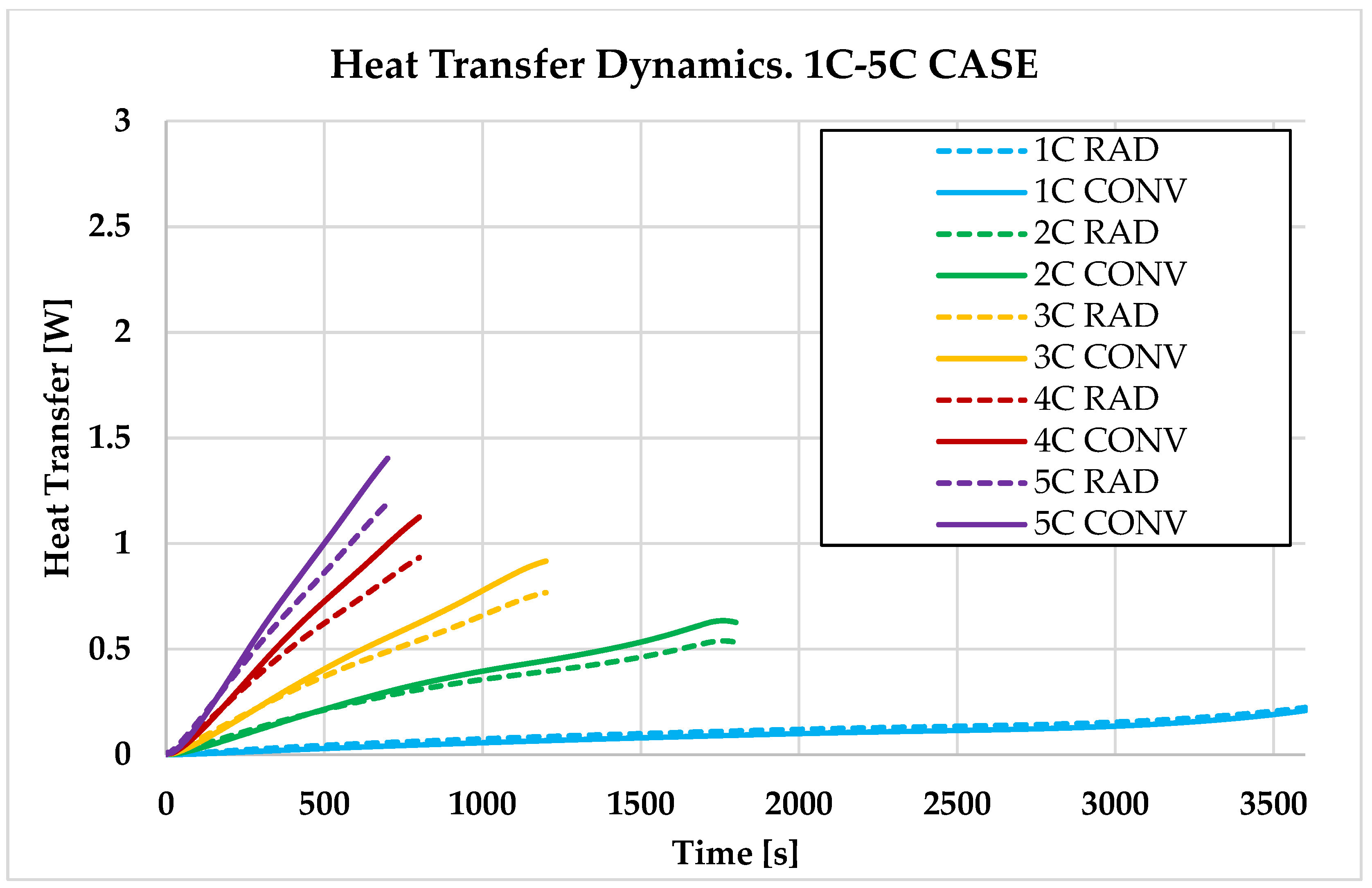
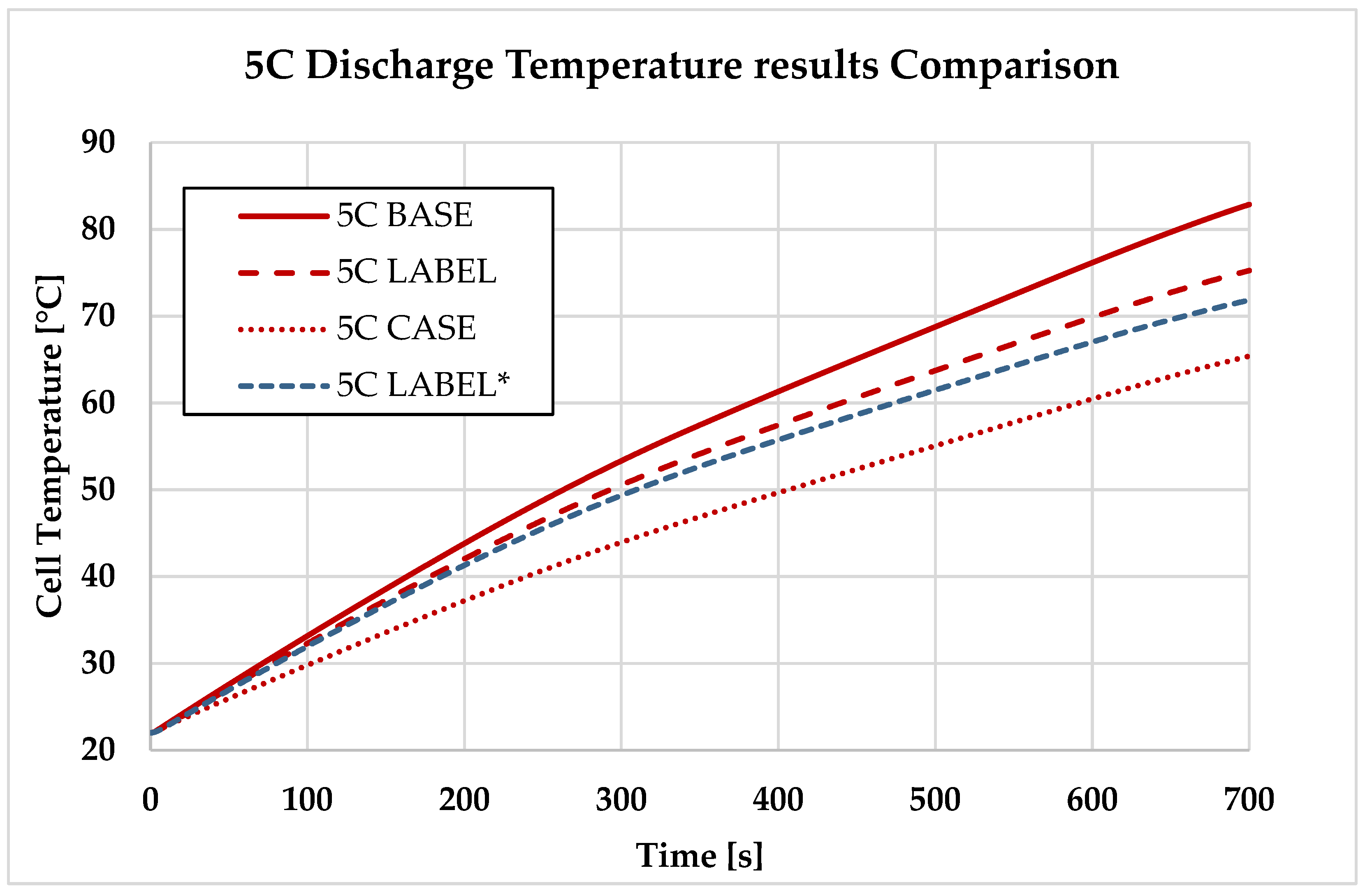
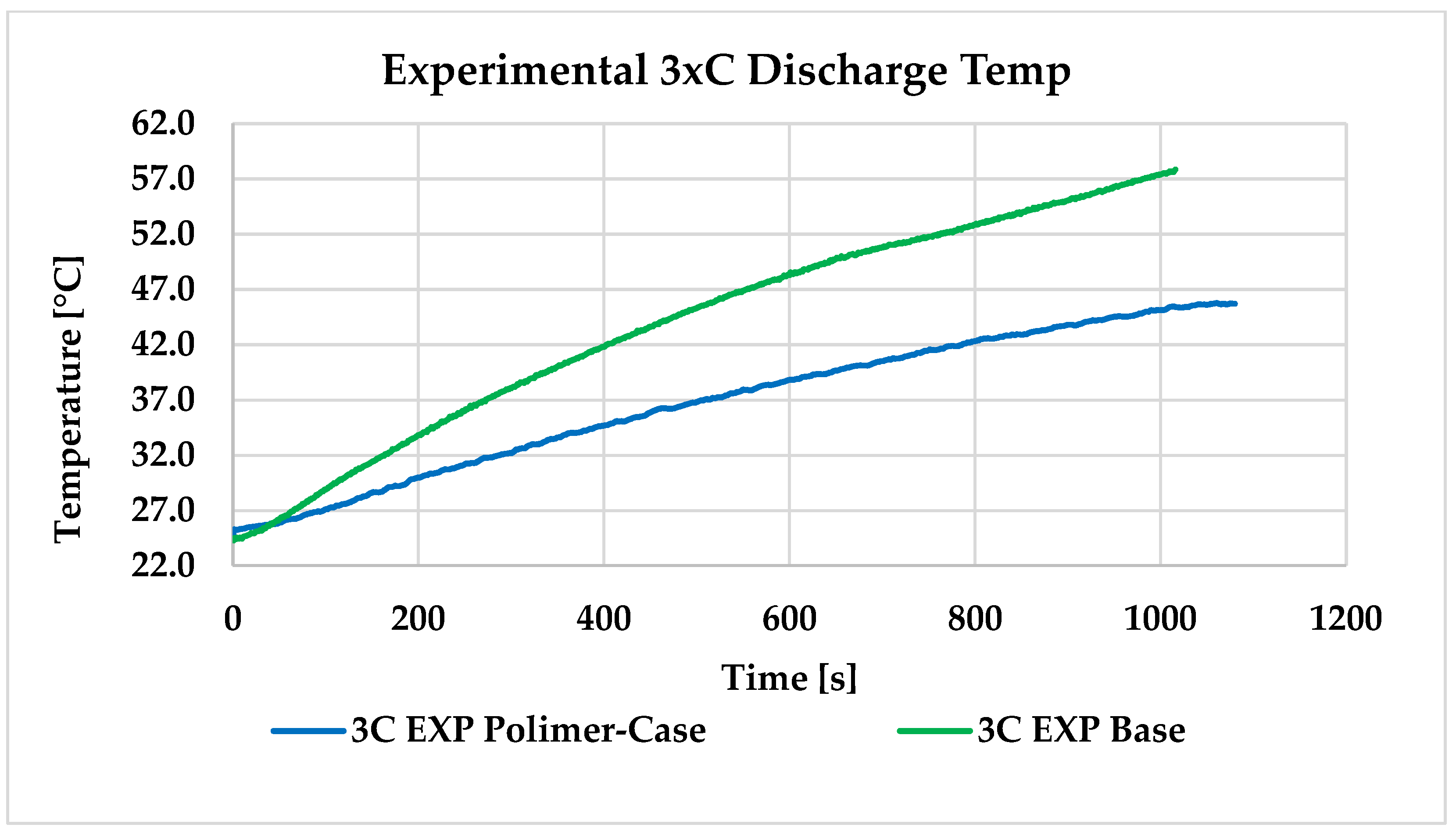
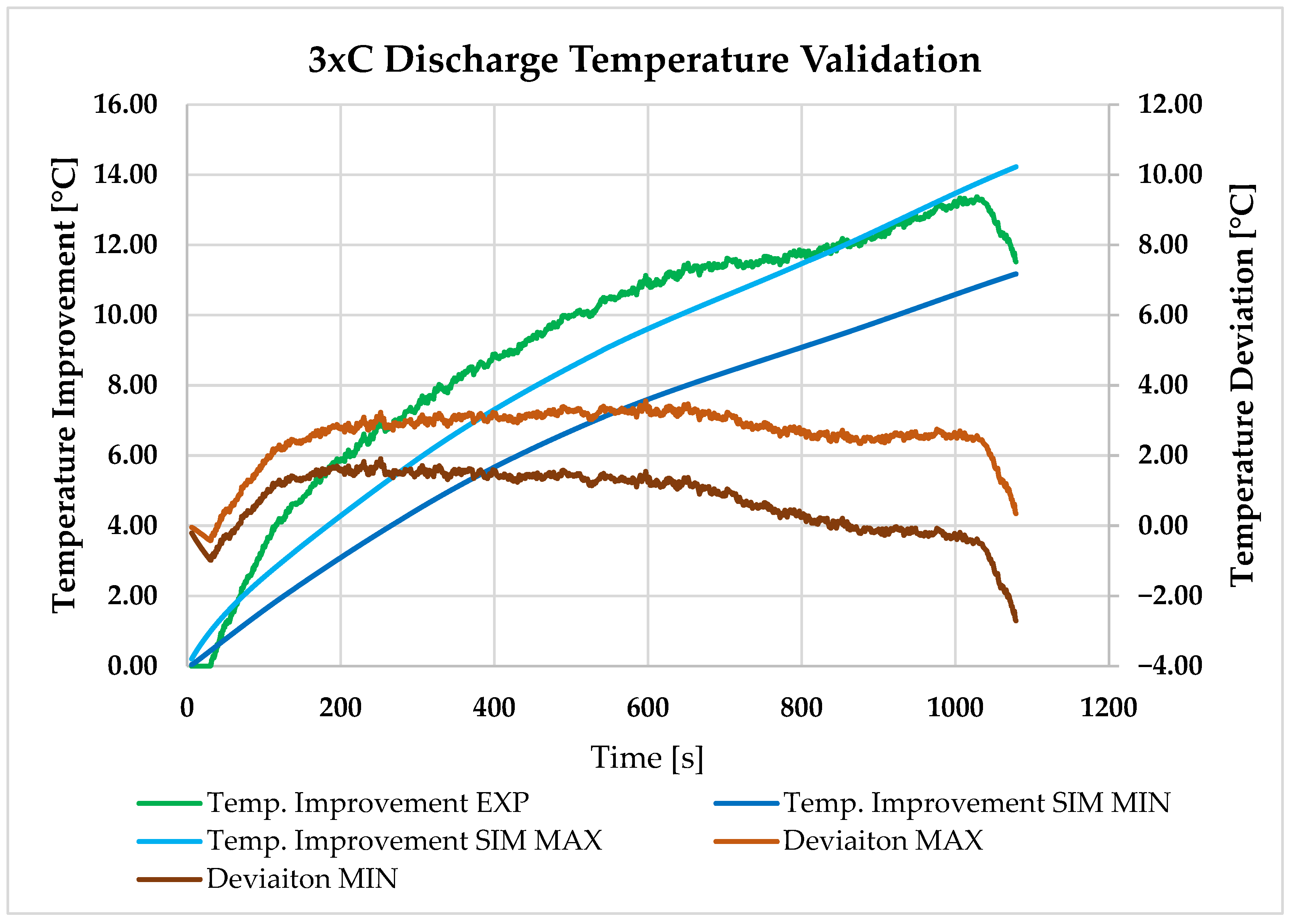
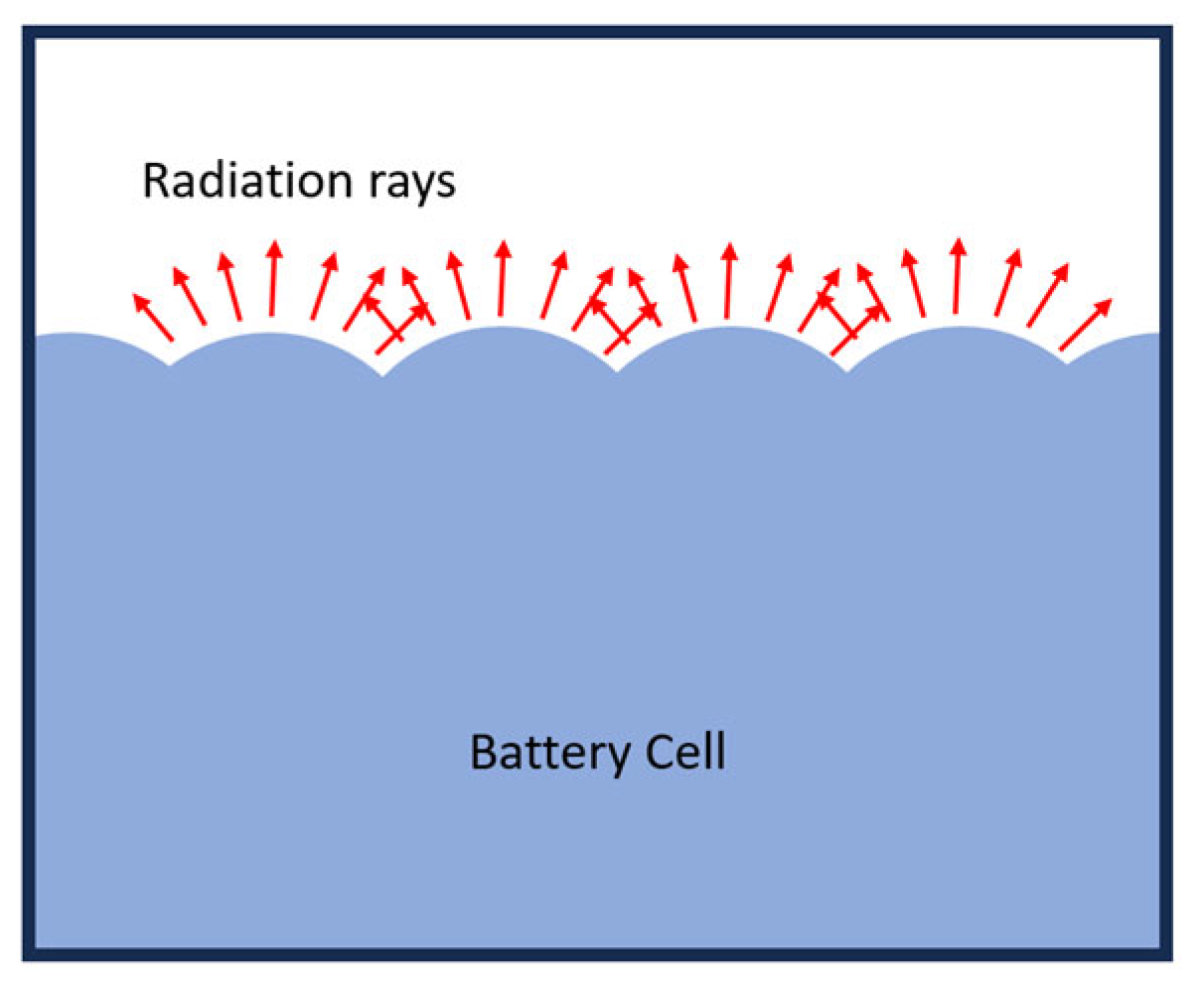
| Parameter | Instrument/Sensor | Range/Resolution | Estimated Uncertainty | Type |
|---|---|---|---|---|
| Current (I) | Elektro-Automatik EL3160-60A (load) (Viersen, Germany) | 0–60 A, 1 mA resolution | ±0.5% of reading ±20 mA | Absolute/±% |
| Voltage (U) | NI 9201 DAQ (12-bit, ±10 V range) (Austin, TX, USA) | ~4.88 mV resolution | ±25 mV typical | Absolute |
| Temperature (T_cell) | LMT85 analog sensor (Texas Instruments, USA) | –50 °C to +130 °C | ±0.4 °C (typical, −20 °C to 100 °C) | Absolute |
| Time (t) | NI system clock via LabVIEW control (Version 14.0.1f11) | — | <±0.1 s | Negligible |
| Case Number | BASE (Pure Cell Can) | Label (Cell Can with Colored Label) | BASE + Polymer Case |
|---|---|---|---|
| 1 | 1×C | 1×C | 1×C |
| 2 | 2×C | 2×C | 2×C |
| 3 | 3×C | 3×C | 3×C |
| 4 | 4×C | 4×C | 4×C |
| 5 | 5×C | 5×C | 5×C |
| Regions | Material | Dimension (mm) | Density (kg/m3) | Specific Heat (J/(kg K)) | Thermal Conductivity |
|---|---|---|---|---|---|
| Fluid | Air | 250 × 250 × 100 | Incompressible ideal gas | 1003 | 0.025 |
| Cell Core | Composite | D = 21 h = 70 | 2500 | 900 | Radial direction = 1.106 Axial direction = 20 |
| Cell Can | Al | Thickness = 0.35 | 2790 | 903 | 238 |
| PVC Label | PVC | Thickness = 0.10 | 920 | 1000 | 0.334 |
| PLA Case | PLA | Thickness = 2.00 | 1430 | 1800 | 0.13 |
| Regions | Material | Dimension (mm) | Density (kg/m3) | Specific Heat (J/(kg K)) | Thermal Conductivity |
|---|---|---|---|---|---|
| Fluid | Air | 250 × 250 × 100 | Incompressible ideal gas | 1003 | 0.025 |
| Cell Core | Composite | D = 21 h = 70 | 2500 | 900 | Radial direction = 1.106 Axial direction = 20 |
| Cell Can | Al | Thickness = 0.35 | 2790 | 903 | 238 |
| PVC Label | PVC | Thickness = 0.10 | 920 | 1000 | 0.334 |
| PLA Case | PLA | Thickness = 2.00 | 1430 | 1800 | 0.13 |
| Material | Thickness (mm) | Refractivity Index | Surface Emissivity | Diffuse Fraction | Absorption Coefficient | Scattering Coefficient (m−1) | |
|---|---|---|---|---|---|---|---|
| Cell Can | Al | 0.3 | 1.5 | 0.1 | 0.1 | 1 × 107 | 0 |
| Lable | PVC | 0.1 | 1.5 | 0.65 | 1 | 10,000 | 1000 |
| Case | PLA | 2 | 1.5 | 0.95 | 1 | 10,000 | 1000 |
| Chamber Wall Properties | Material | Thickness (mm) | Emissivity | Diffuse Fraction |
|---|---|---|---|---|
| Side | Al | 2 | 0.2 | 0.1 |
| Bottom | Al | 2 | 0.95 | 1 |
| Top | Al | 2 | 0.85 | 1 |
| BASE | LABEL | CASE | |
|---|---|---|---|
| Discharge | End Temp (°C) | End Temp (°C) | End Temp (°C) |
| 1C | 35.71 | 32.97 | 31.28 |
| 2C | 51.58 | 46.49 | 43.24 |
| 3C | 63.49 | 57.32 | 51.73 |
| 4C | 71.93 | 65.51 | 57.66 |
| 5C | 82.86 | 75.26 | 65.40 |
| BASE | LABEL | CASE | |||||||||||||
|---|---|---|---|---|---|---|---|---|---|---|---|---|---|---|---|
| Discharge | Total Heat Transfer (W) | Convection Heat Transfer Ratio (%) | Radiation Heat Transfer Ratio (%) | Airflow (m/s) | Htc (W/m2k) | Total Heat Transfer (W) | Convection Heat Transfer Ratio (%) | Radiation Heat Transfer Ratio (%) | Airflow (m/s) | Htc (W/m2k) | Total Heat Transfer (W) | Convection Heat Transfer Ratio (%) | Radiation Heat Transfer Ratio (%) | Airflow (m/s) | Htc (W/m2k) |
| 1C | 0.42 | 91% | 9% | 0.08 | 6.97 | 0.49 | 60% | 40% | 0.07 | 9.98 | 0.43 | 48% | 52% | 0.06 | 11.56 |
| 2C | 1.14 | 92% | 8% | 0.12 | 8.71 | 1.29 | 65% | 35% | 0.11 | 11.81 | 1.16 | 54% | 46% | 0.10 | 13.34 |
| 3C | 1.71 | 92% | 8% | 0.14 | 9.33 | 2.00 | 65% | 35% | 0.13 | 12.72 | 1.69 | 54% | 46% | 0.11 | 14.16 |
| 4C | 2.14 | 92% | 8% | 0.15 | 9.69 | 2.58 | 65% | 35% | 0.14 | 13.27 | 2.06 | 55% | 45% | 0.12 | 14.61 |
| 5C | 2.70 | 92% | 8% | 0.16 | 10.04 | 3.31 | 64% | 36% | 0.15 | 13.93 | 2.60 | 54% | 46% | 0.13 | 15.27 |
Disclaimer/Publisher’s Note: The statements, opinions and data contained in all publications are solely those of the individual author(s) and contributor(s) and not of MDPI and/or the editor(s). MDPI and/or the editor(s) disclaim responsibility for any injury to people or property resulting from any ideas, methods, instructions or products referred to in the content. |
© 2025 by the authors. Licensee MDPI, Basel, Switzerland. This article is an open access article distributed under the terms and conditions of the Creative Commons Attribution (CC BY) license (https://creativecommons.org/licenses/by/4.0/).
Share and Cite
Kovács, G.; Kocsis Szürke, S.; Fischer, S. Investigation of Convective and Radiative Heat Transfer of 21700 Lithium-Ion Battery Cells. Batteries 2025, 11, 246. https://doi.org/10.3390/batteries11070246
Kovács G, Kocsis Szürke S, Fischer S. Investigation of Convective and Radiative Heat Transfer of 21700 Lithium-Ion Battery Cells. Batteries. 2025; 11(7):246. https://doi.org/10.3390/batteries11070246
Chicago/Turabian StyleKovács, Gábor, Szabolcs Kocsis Szürke, and Szabolcs Fischer. 2025. "Investigation of Convective and Radiative Heat Transfer of 21700 Lithium-Ion Battery Cells" Batteries 11, no. 7: 246. https://doi.org/10.3390/batteries11070246
APA StyleKovács, G., Kocsis Szürke, S., & Fischer, S. (2025). Investigation of Convective and Radiative Heat Transfer of 21700 Lithium-Ion Battery Cells. Batteries, 11(7), 246. https://doi.org/10.3390/batteries11070246







